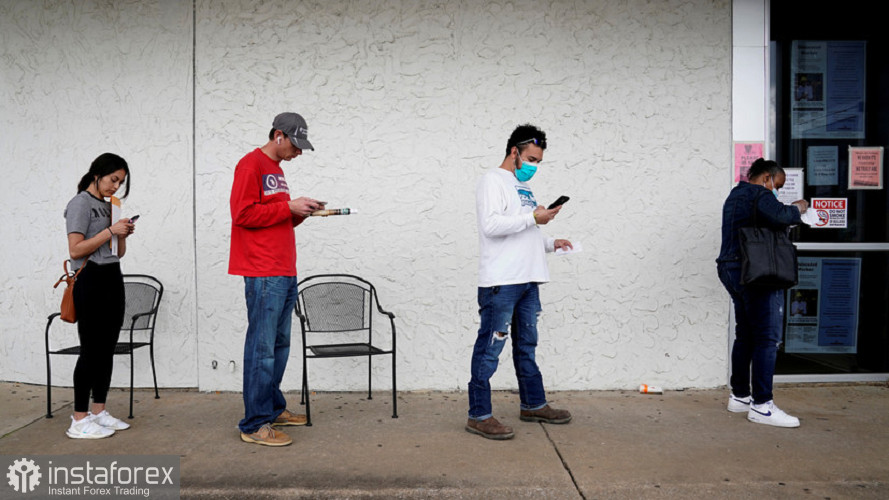According to the reports, the total number of Americans who applied for unemployment benefits exceeded a three-month maximum. Experts believe that the latest wave of COVID-19 infections is to blame, which has disrupted only the revived business activity, signs of revival of which are showing job growth.
Employment reports do not meet the expectations of the Fed and the markets
Despite increased labor demand, initial jobless claims rose 55,000 to a seasonally adjusted 286,000 for the week ended January 15. This is the maximum since mid-October, which was reported on Thursday by representatives of the Ministry of Labor. The overall increase was the largest since July last year.

"Even with the usual buzz in the numbers, they seem to reflect the record increase in COVID-19 cases from Omicron," said Robert Frick, corporate economist at the Navy Federal Credit Union of Virginia.
"Fortunately, Omicron is at its peak, and if past models persist, applications should decline rapidly in the next two to three weeks," he said.
In the meantime, economists are disappointed, as the median forecast fluctuated at the figure of 220,000 applications for the last week.
Unadjusted benefit applications declined last week. However, this decrease was less than expected (taking into account seasonal factors that the government uses to exclude seasonal fluctuations from the data).
Applications increased by 6,075 in California. But they fell by 14,011 in New York. There were also big drops in Missouri and Texas.
The United States reports an average of 732,245 new cases of omicron coronavirus infection per day, according to official government data. However, there are signs that in some regions, including hard-hit New York, the number of cases is beginning to decrease.
Applications may begin to decline as the number of cases of infection decreases.
And yet it may not just be a seasonal outbreak.
Thus, conditions in the labor market are tightening. Employers are in desperate need of workers: 10.6 million vacancies were opened at the end of November.
But what if some of these vacancies have unadjusted wages for inflation? It is known that wage growth always lags behind inflation. Taking into account the huge migration of employees noticed in December last year, it is possible that the most "delicious" vacancies were dismantled, leaving former employers with empty jobs. How competitive are these 10 million vacancies? This hidden factor does not allow us to estimate the actual capacity of the employment market.
Currently, the unemployment rate is at a 22-month low of 3.9%, which is a sign that the labor market is at or close to maximum employment. The question remains, where do 10 million vacancies come from if the real sector is going through hard times due to supply disruptions and the rise in the cost of components?
Recall that in December, the economy added 199,000 jobs, which is the lowest figure for the year. This shows that the economy has slowed down the recovery. At the same time, the last two years have "taken away" 2.2 million able-bodied residents from the United States. Given the weak reflation, it is not entirely clear why there is such a stir around the search for labor?
The application data covers the period during which the government surveyed businesses for the non-agricultural component of wages in the employment report for January. At first glance, applications significantly exceed their level in mid-December. However, the actual conditions may differ from those described in the application.
Along with this obvious discrepancy between the two indicators, experts note that the shortage of workers and disruptions caused by Omicron due to absenteeism, reduction of operations, or temporary closure of enterprises may lead to wage growth remaining moderate this month. If this happens, at the end of January, we will see a new surge in applications for unemployment benefits, which will offset the gains from the effect of the weakening of the coronavirus.
The report on secondary applications showed that the number of people receiving benefits after the first week of assistance increased from 84,000 to 1.635 million in the week ending January 8. These so-called continuing applications remained below 2 million for the eighth week in a row. However, the growth of extended benefits is impressive.
These figures suggest that the reports are lying: there are much fewer jobs that are competitive and ready to accept people today, otherwise, we would have seen an impressive increase in production and sales, which contradicts the data. My opinion remains the same: the government is wishful thinking to quickly introduce an upward regime of interest rates, putting a barrier to rampant inflation.
In the meantime, the latest reports on applications will hit the indices, although they are still growing. The yield of 10-year benchmark bonds is also rising, and the spot dollar rose by 0.03%. The euro/dollar pair is falling, the indices are also likely to turn around during the American session.
 English
English 
 Русский
Русский Bahasa Indonesia
Bahasa Indonesia Bahasa Malay
Bahasa Malay ไทย
ไทย Español
Español Deutsch
Deutsch Български
Български Français
Français Tiếng Việt
Tiếng Việt 中文
中文 বাংলা
বাংলা हिन्दी
हिन्दी Čeština
Čeština Українська
Українська Română
Română

